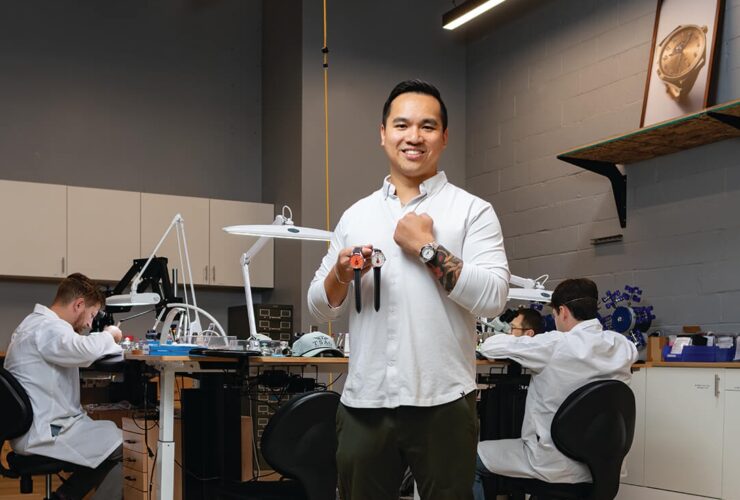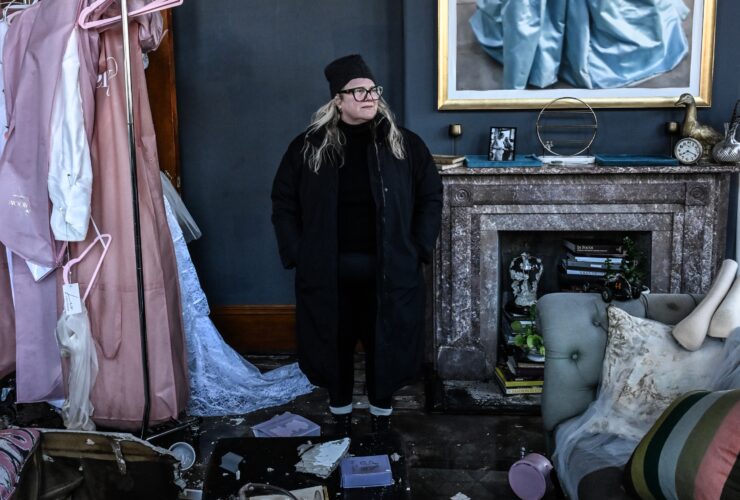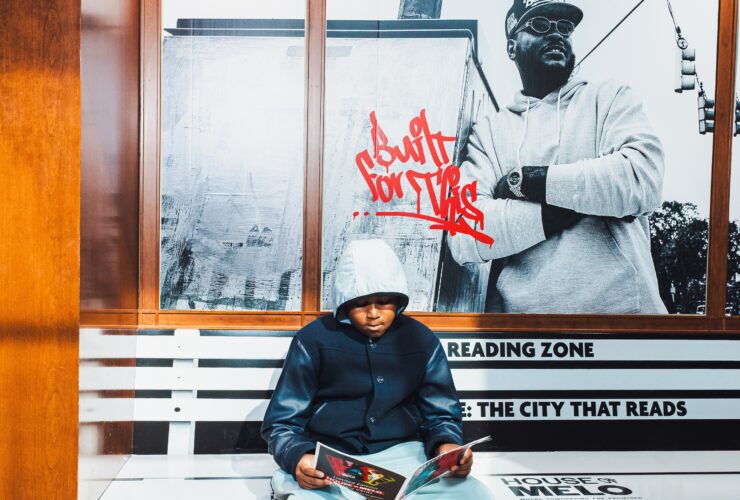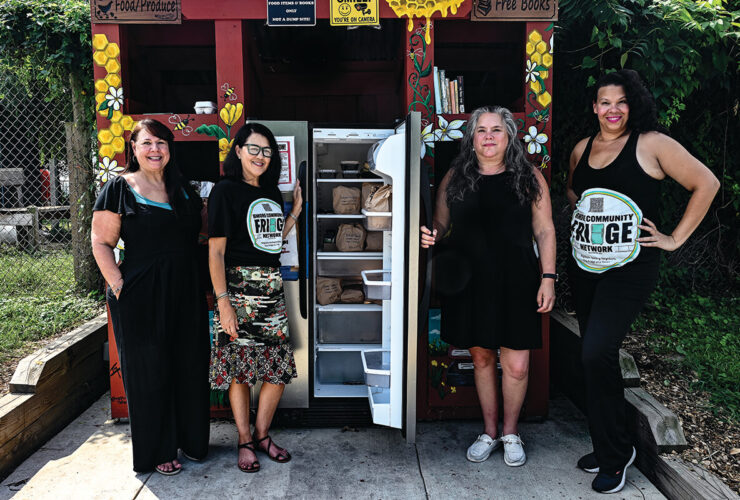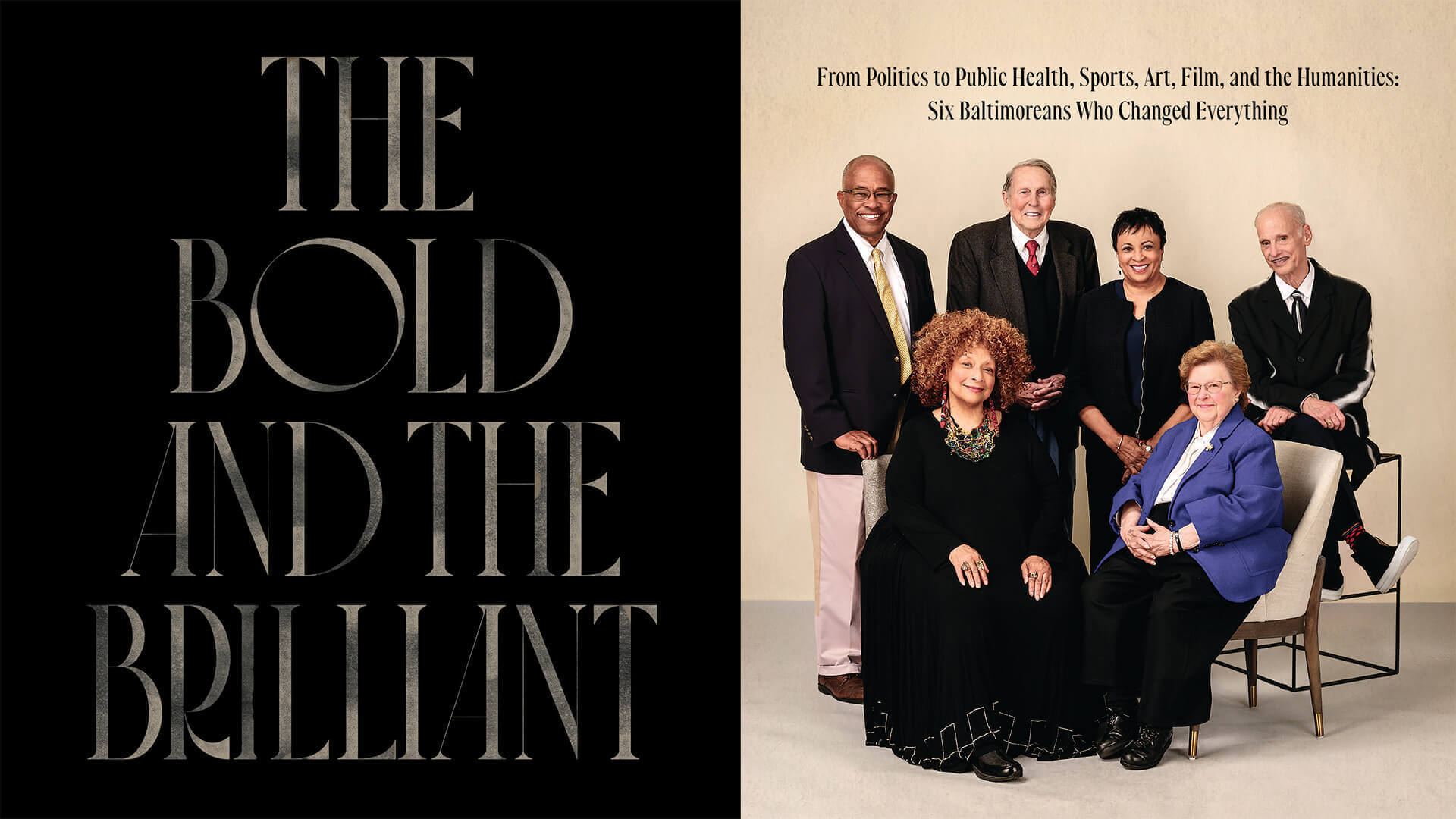
News & Community

Edited by Ron Cassie
PHOTOGRAPHY BY CHRISTOPHER MYERS
LETTERING BY LUKE LUCAS
HAIR & MAKEUP: BRIAN OLIVER, T.H.E. ARTIST AGENCY. PROPS: LIMONATA CREATIVE
VIDEO BY CURT ISELI
 HEN CARLA HAYDEN ARRIVED for the photograph that graces this month’s cover, (above), I
practically ran down the hallway to greet her. If there
is such a thing as a famous librarian, it’s the revered
Hayden, the 14th librarian of Congress, and the first
woman and first Black American to hold the position.
HEN CARLA HAYDEN ARRIVED for the photograph that graces this month’s cover, (above), I
practically ran down the hallway to greet her. If there
is such a thing as a famous librarian, it’s the revered
Hayden, the 14th librarian of Congress, and the first
woman and first Black American to hold the position.
For 23 years prior to her appointment by then-President Obama, she of course served as CEO of the Enoch Pratt Free Library system and, years before, she’d led me on a behind-the-scenes tour of Baltimore’s historic Central Library in Mount Vernon. She and her staff joyfully revealed the secrets of the place—from a lock of Edgar Allan Poe’s hair and one of Tupac Shakur’s early hand-written raps, to its old-world bindery and shipping department, which lends books out across Maryland, including to the state’s jails and prisons. (“It’s not true that prisoners only ask for legal books,” a shipping supervisor had told me. “They ask for the same books as everybody else.”) That same day, Sen. Barbara Mikulski, on this month’s cover as well, happened to be giving a Women’s History Month talk in the auditorium. It was also, coincidentally, St. Patrick’s Day and so several other talented Pratt staff members played Irish music in the main hall—as Hayden cheerfully passed out cookies to an appreciative audience. I thought I had a strong affection for public libraries before but ever since that day at the Pratt with Hayden, I’ve treasured them.
“My library,” philanthropist Enoch Pratt had said when he made his founding bequeathment, “shall be for all, rich and poor, without distinction of race or color,” and no one embodies that spirit better than the down-to-earth Hayden, who still lives in the city and brought her 91-year-old mother to the photo shoot, “because she’s never been to one.” Her leadership, infectious enthusiasm, expansive vision of public libraries, and resolve, when necessary, has been nothing short of transformative at both the Pratt and Library of Congress. Working with her branch managers, she kept all the Pratt libraries open in the days following the 2015 Uprising, showing up the morning after the riots at the Pennsylvania Avenue Branch to help distribute water and necessities. “You can’t ask your staff to do anything that you are not willing to do,” she says.
The idea behind our January cover story, which pays homage to a collection of once-in-a-lifetime trailblazers—Hayden, Mikulski, Brooks Robinson, John Waters, Joyce Scott, and Kurt Schmoke— whose impact has been felt well beyond the city, had been kicking around for some time. The purpose isn’t to bask in nostalgia. Remarkably, most of our cover subjects are still keeping schedules that would exhaust someone half their age. But rather: recognition, understanding, and inspiration. The coming of a new year is, traditionally, a liminal moment of reflection and resolution as we look forward. Who better to learn from than this wildly diverse group?
Together, they are a set of extraordinarily accomplished, yet completely different personalities, by turns provocative, principled, cerebral, compassionate, feisty, funny, resilient, self-deprecating, over-the-top, and—the qualities closest to the hearts of Baltimoreans—loyal and unpretentious.
“Who better to learn from than this wildly diverse group? . . . They each charted a unique, purposeful, and often applecart-upsetting path.”
They each charted a unique, purposeful, and often applecart-upsetting path. John Waters’ outrageous perversion of outdated morality codes with films like Pink Flamingos may spring to mind, but so should then-social worker Barbara Mikulski’s battle against City Hall to save her beloved Fells Point. As should Kurt Schmoke’s courageous stance against the War on Drugs and public-health-centered approach to treating addiction and other city ills.
Meanwhile, the work of the rebellious and irrepressible Joyce Scott, who has described herself as a “true Baltimore babe and Sandtown girl,” can be found in major institutions, from New York’s Metropolitan Museum of Art to the Smithsonian’s American Art Museum. A spiritual force of nature, she is an outspoken social justice warrior and the city’s greatest living visual artist.
Brooks Robinson, as anyone who has ever met him will attest, represents an almost radical civility. Not a civility that’s been lost, but an authentic kindness extended without prejudice to every individual, which has always been in short supply. It’s the reason generations of Baltimoreans named their little boys and girls and, yes, family pets after him. The close friendship between the Robinsons—Little Rock-native Brooks and Oakland-born Frank, the Orioles’ Hall of Fame co-leaders during the tumultuous 1960s—set an example for Baltimore and the country.
Few cities could produce such an eclectic mix of role models, and Baltimore remains a place where you can become a groundbreaking filmmaker, artist, civic leader, mayor, U.S. senator—or the greatest third baseman ever—and remain true to your heart.
The initial surprise to me, and to creative director Amanda White-Iseli and photographer Chris Myers, who shot the wonderful portraits below, is that our group, for the most part, was already very familiar with each other. Waters and Scott embraced and tried to remember the last time they were in the Clipper Mill studio building together—decades ago, maybe the ’70s, they thought. It seemed just the 86-year-old Robinson, whose portrait Norman Rockwell once painted, hadn’t previously met everyone on hand. He knew Mikulski, naturally, who is the same age and a lifelong Orioles fan. That said, everyone knew Brooks Robinson. John Waters politely asked him for an autograph, which may be about the most Baltimore moment ever.
“I thought they all were so nice,” the soft-spoken Hall of Famer with the Arkansas accent said afterward. “Didn’t you think so?”
In fact, as soon as Hayden stepped inside the studio, she waved to Sen. Mikulski, who was seated and getting her portrait taken, and introduced the longest-serving congresswoman ever to her mother. And then she did the same thing when she saw former Mayor Schmoke, the president of the University of Baltimore since 2014.
“Kurt Schmoke brought me here from Chicago. He called Mayor Daley for a reference,” Hayden explained with a smile. “Barbara Mikulski pushed me forward for librarian of Congress.
“You know this is Smalltimore,” she added. “We look out for each other.”
Below, six people whose bylines many will recognize—Rep. John Sarbanes, for example—write about their experiences with, and admiration for, these Baltimore icons.
—VIDEO BY CURT ISELI

By John Sarbanes
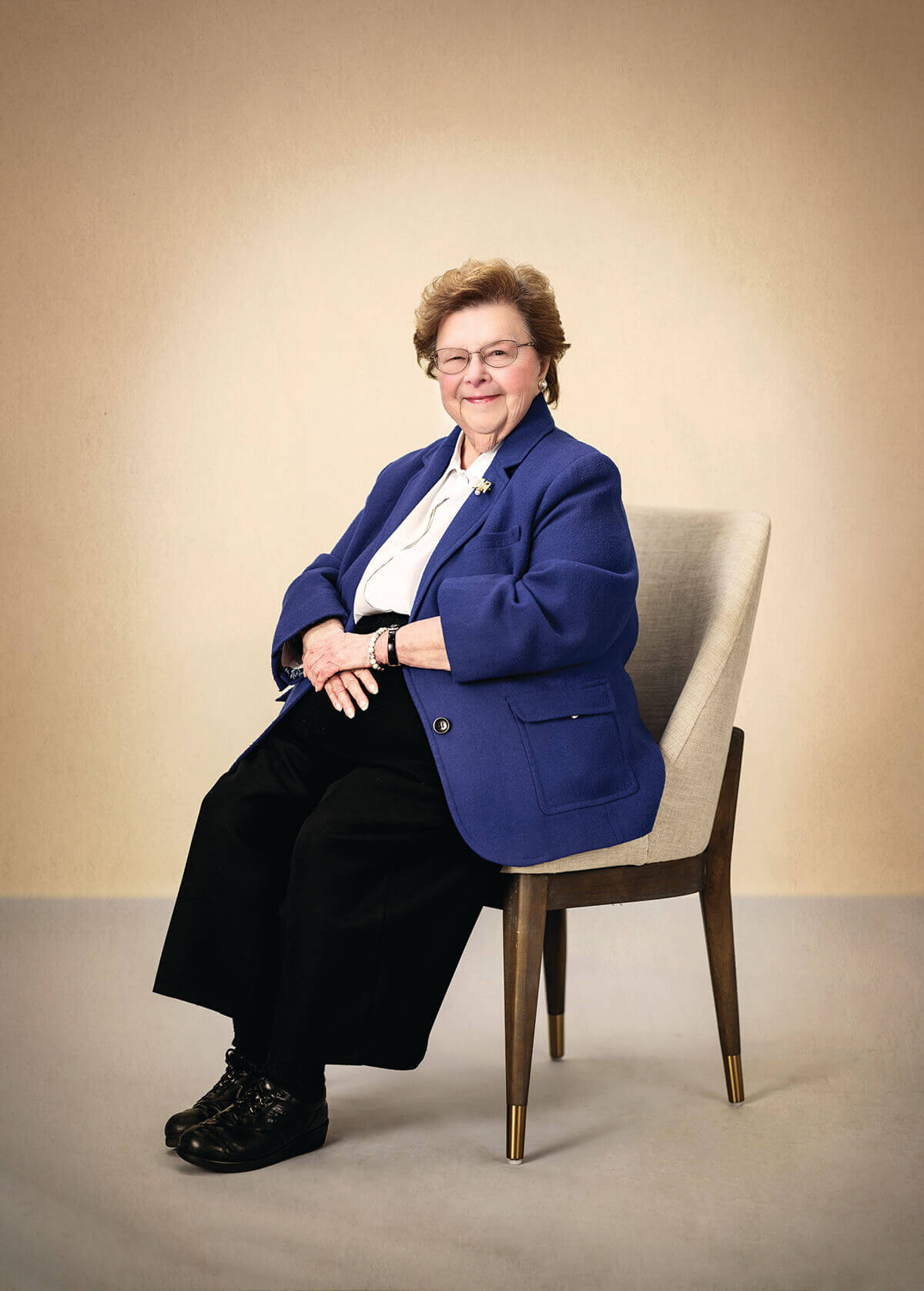
CHAIR COURTESY OF SU CASA
LONGEST-SERVING WOMAN in the history of Congress. First Democratic woman elected to the Senate in her own right. First woman to chair the powerful Senate Appropriations Committee. Second woman ever to serve in both chambers of Congress. Sen. Barbara Mikulski has made history at every turn. Her achievements have improved the quality of life for millions and earned her many titles. But her most cherished title is the one she’s had since birth: Baltimorean.
“When she was serving in Congress. . .I marveled at her ability to connect with people of all walks of life.”
My father, Sen. Paul Sarbanes, was honored and grateful to be Sen. Mikulski’s Maryland teammate in Congress for three decades. They knew each other long before that, however. They met as young reformers in Baltimore, “looking out for the little guy,” as my father used to say. They were cut from the same political cloth and fiercely proud of their ethnic heritage, humble roots, and shared stake in the American dream. My father was the son of a Greek restaurant owner and she is the daughter of Polish corner-store grocers. They’d joke, ribbing Sens. Jay Rockefeller and Ted Kennedy, that they were “Diner Democrats” not “Dynasty Democrats.” Both were raised to help the people around them and to make their community a better place.
Sen. Mikulski first gained attention as a citizen activist in the fight to stop the massive urban highway that was scheduled to cut through the heart of the city from West Baltimore to the Inner Harbor, Federal Hill, Fells Point, and Canton. She drew on her Baltimore tenacity and her training as a social worker to become a masterful legislator and make transformative change. She always looked out for her home state and her hometown—fighting for the Port of Baltimore, cleaning up the Chesapeake Bay, supporting space exploration at NASA Goddard, securing funding for the NIH and the FDA, as well as doing countless unseen things that changed the lives of individual Marylanders.
When Sen. Mikulski was first elected, she was often asked how it felt to be the only Democratic woman in the Senate. She’d famously respond, “Though I was the first, I don’t want to be the only,” and spent her career fighting for women and inspiring them to serve. With Texas Republican Sen. Kay Bailey Hutchison, she launched bipartisan dinners for female senators which continue to this day. Her legislative accomplishments speak for themselves: She helped to establish the Office of Research on Women’s Health at the NIH, passed the Spousal Anti-Impoverishment Act that protected millions of women from going into bankruptcy when their husbands needed long-term nursing care, and championed the Lilly Ledbetter Fair Pay Act, which helped ensure women get equal pay for equal work.
I was also privileged to serve with Sen. Mikulski, and she remains a friend and mentor. When she was serving in Congress, we always had a good time at political events where I marveled at her ability to connect with people of all walks of life. She has the magic touch, which includes a certain genius for coming up with a turn of phrase that captures the moment. After experiencing these golden nuggets whenever we were together, I took to recording them as “Mikulskiisms”—things like: “I don’t finger point, I pinpoint.” “Focus on macro issues and macaroni and cheese issues.” Channeling her power as a Senate appropriator, “Where there’s a will, there’s a wallet!”
There are literally hundreds of these insights on life and politics, and usually Sen. Mikulski arrived at them on the spot. But some she repeated because they had special meaning. Whenever she was with a group of volunteers, she showed her deep appreciation for their contributions by acknowledging, “All you do on your own dime and your own time.” And my favorite, her words of wisdom on how to navigate the rough seas of the human condition: “The best, most important ship in life is friendship.”
A scrappy and determined fighter for the people, Barbara Mikulski broke barriers to become a United States senator. But, perhaps more importantly, she always found a way to break through the red tape to help those who had been forgotten and overlooked. She started her career in Baltimore as a social worker and, in her description, she ended her career as a “social worker with power.”
Rep. John Sarbanes is a native Baltimorean and has represented Maryland’s 3rd congressional district since 2007.

By Peter Beilenson
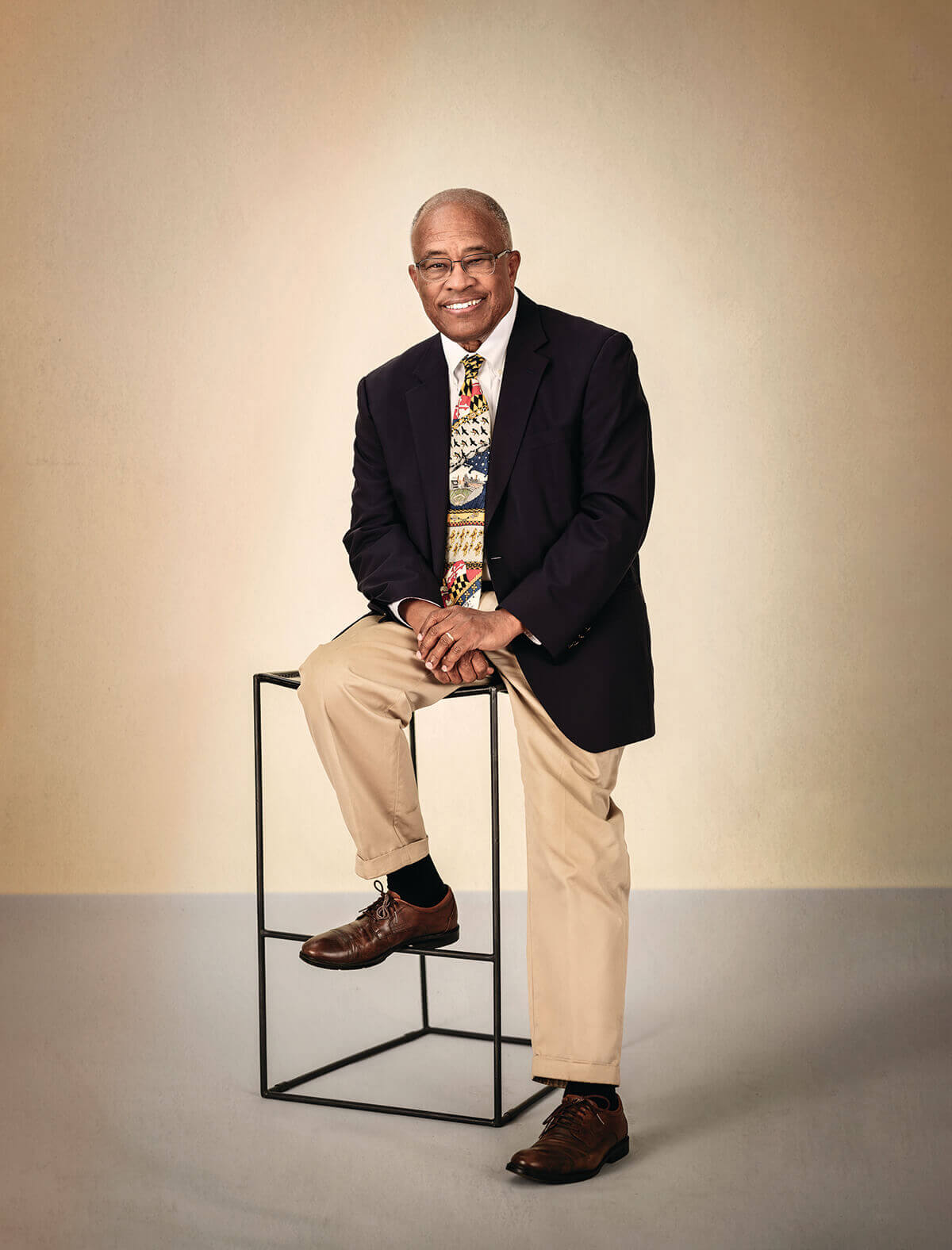
STOOL COURTESY OF ARHAUS
OWING TO HIS PRESCIENT STANCE on drug policy reform, Kurt Schmoke is one of the most influential national politicians of the past 30 years. The first Black elected mayor of Baltimore and a rising political star, he knew such a position could be a death knell to any future goals of running for the U.S. Senate or earning a Cabinet appointment. I remember one ride we took together to Annapolis, in 1994, when he told me that he could easily devise the bumper sticker of a hypothetical campaign against him: “Schmoke: Soft on Drugs, Soft on Crime.” But he felt so strongly that the “War on Drugs” was destructive, he went ahead not only with speeches about drug policy reform, but real policy changes in the city. Some shifts, like treating drug addiction as a public health problem rather than a criminal justice issue, led directly to their widespread implementation, with these policies now accepted by large bipartisan majorities in much of the country.
“Mayor Schmoke was not all gentle persuasion, though. . .he could play hardball if the issue at hand was important.”
The needle exchange program he championed was a perfect example of how this thoughtful, gentlemanly politician usually pursued policy change. Rather than attack legislators who opposed the implementation of needle exchange, he launched a two-pronged approach:
1) Gather as much support from a variety of organizations as possible. We asked every group we spoke to for a letter of support for needle exchange and to advocate for this important tool for preventing AIDS in intravenous drug users. 2) Put together a terrific team of Johns Hopkins infectious disease and public health specialists to testify at the legislative hearings. This worked to get the piece of legislation passed by the General Assembly. Getting Governor William Donald Schaefer on board was another story.
Mayor Schmoke was not all gentle persuasion, though. In addition to the soft sell, he could play hardball if the issue at hand was important. Indeed, needle exchange commanded such a response from Schmoke. Few know this, but when then-Governor Schaefer threatened to veto the needle exchange legislation if it passed, Schmoke used me as the messenger to give notice to the governor through back channels that if he continued to oppose the bill, the mayor and I would start providing needles to clients ourselves and force Schaefer to get the state police to arrest us. Unwilling to face the backlash of arresting the very popular Black mayor of the largest city in the state (and his sidekick, the new white health commissioner), the governor not only backed down, but actually introduced the bill in the General Assembly, which the late Elijah Cumming sponsored, and signed it into law. To this day, Baltimore’s needle exchange program is recognized as one of the most effective programs of its kind in the country.
It was very easy to work for Mayor Schmoke. Unlike some politicians who followed whatever way the wind was blowing, the science and data behind an issue was all that mattered to him. Thus, he supported his leadership staff in whatever we wanted to do—as long as there was good evidence that a given action or program would likely be effective. One such controversial effort we launched was Norplant (an implantable form of birth control) in high schools, which was found to be very effective at preventing unwanted pregnancies in teens. Quickly, the program attracted significant populist opposition, and national attention, accompanied by a call for my head for implementing what was characterized as genocide by the opponents. But rather than leave me hanging, which would arguably have been politically prudent, Schmoke doubled down, both defending me and taking responsibility for okaying the program.
The integrity Mayor Schmoke showed in his willingness to risk political ambitions to speak out and act on controversial issues led me, and others, to develop great respect for him. And, while I consider Kurt Schmoke to be one of the five smartest people I know, what led to my deep devotion to him was not his brainpower, but rather the respectful way he treated staff and citizens alike. Indeed, if you ask almost any member of his staff, they will invariably say that the years of working for Schmoke were the best of their working lives.
Dr. Peter Beilenson served as Baltimore City’s health commissioner between 1992 and 2005 and the Howard County health director from 2007 to 2012.

By Jim Henneman
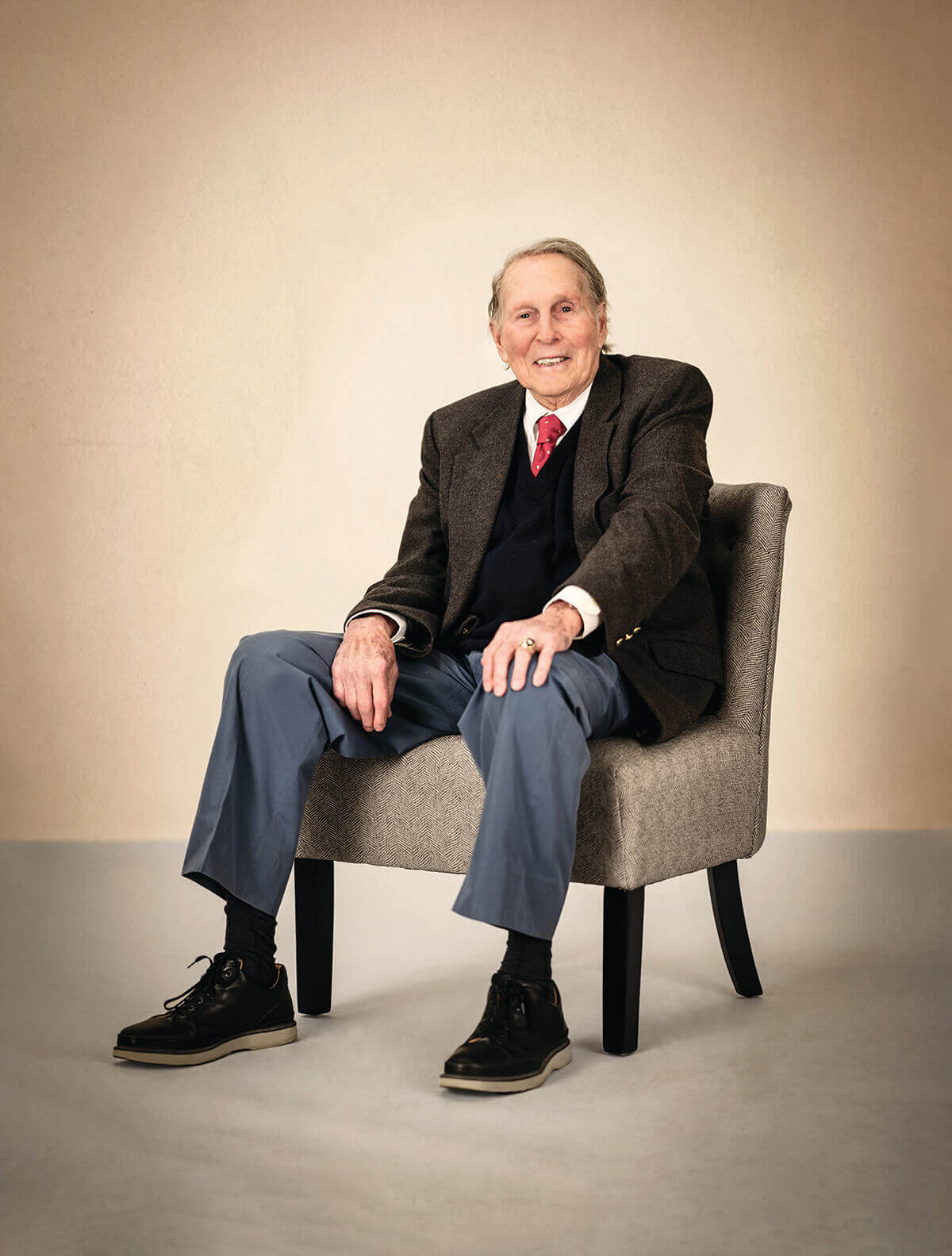
STOOL COURTESY OF ARHAUS
LIKE HUNDREDS OF AMERICAN LEAGUE hitters and thousands of baseball fans, especially from Baltimore, I vividly recall my first memory of Brooks Robinson. I don’t remember the exact date, but I remember the play. It was a game in September 1956. He was 19 and playing his second year of professional baseball. I was in my third year at Loyola College and moonlighting as an usher in the left-field upper deck at Memorial Stadium.
It was one of those wow plays, very similar to the kind the Cincinnati Reds would witness years later when Brooks led the Orioles to the 1970 World Series title and earned MVP honors. There was a crack of the bat followed by a shooting line drive down the third-base line that went past him and the bag—until it didn’t. What began as a surefire double ended up as an out after a spectacular diving catch and Brooks’ quick throw to first. From my elevated vantage, it was the best play I’d ever seen. Sixteen Gold Gloves eventually followed.
“...it was Brooks who had led the Orioles to the top. The man’s ability was outweighed only by his humility.”
Brooks’ first full season in 1958 was the same year I started writing for the Baltimore News-American. There were many additions to the memory bank, including some personal ones. In 1963, when Brooks’ career was going full speed and mine was still in first gear, my first Opening Day road game turned into a bizarre assignment. For some reason, there was no bat boy for the visiting Orioles, and having had some experience in the O’s minor-league days, I volunteered— something not imaginable today, but those were simpler times, and I was a kid just a few years out of college. Guess who donated a pair of his size-10 spikes to complete my uniform? Fast forward two decades. As a national officer of the Baseball Writers’ Association of America in 1983, I had the honor of participating in Brooks’ Hall of Fame induction ceremony.
When his career was over, Brooks spent years working on the Orioles’ television-announcing crew. He’d be the first to tell you he was more a “color” announcer than an analyst, and it was then, traveling together as we covered the team, that I really got to appreciate the genuineness of his folksy, good-hearted nature—the real reason people in Baltimore named their little boys, and girls, too, after him.
As a player, Brooks was a trailblazer only in the sense that he was the Orioles’ first superstar, the leader of a young pack who lifted the organization to the best record in sports. It was off the field, in the clubhouse and the community, where his soft-spoken modesty and leadership spoke volumes. Never more so than when the Orioles obtained future Hall of Famer Frank Robinson in a blockbuster trade after the 1965 season. Brooks was already a six-time All-Star and one year removed from American League Most Valuable Player honors. The addition of another superstar, a Black slugger who shared his last name, who’d been labeled “a troublemaker” by his previous club’s owner, could’ve potentially disrupted the team’s chemistry.
But while Frank dealt with remnants of legal segregation that still existed in Baltimore, his acceptance in the O’s clubhouse was a non-issue from the jump. Brooks’ stature was such that he did not have to step back to make room for anyone. But make no mistake about this, the way he graciously moved aside, as though making room for a co-pilot, set the tone for a run that produced six pennants and two World Championships in the six years they hit back-to-back in the middle of the O’s lineup. In fact, the pair became known as the “Robinson Brothers,” and even made a Lite Beer commercial together playing off their names and similarities, explaining, however, “we are not identical twins.”
As their careers wound down, Brooks often said Frank, “was the best player I ever played with—and I think one of the best of all time.” He also said: “[Frank] put us over the top.” Left unsaid, and make no mistake about this either, it was Brooks who had led the Orioles to the top. The man’s ability was outweighed only by his humility.
Jim Henneman is a past president of the Baseball Writers’ Association of America and is now in his eighth decade covering baseball and the Orioles.

By Leslie King Hammond
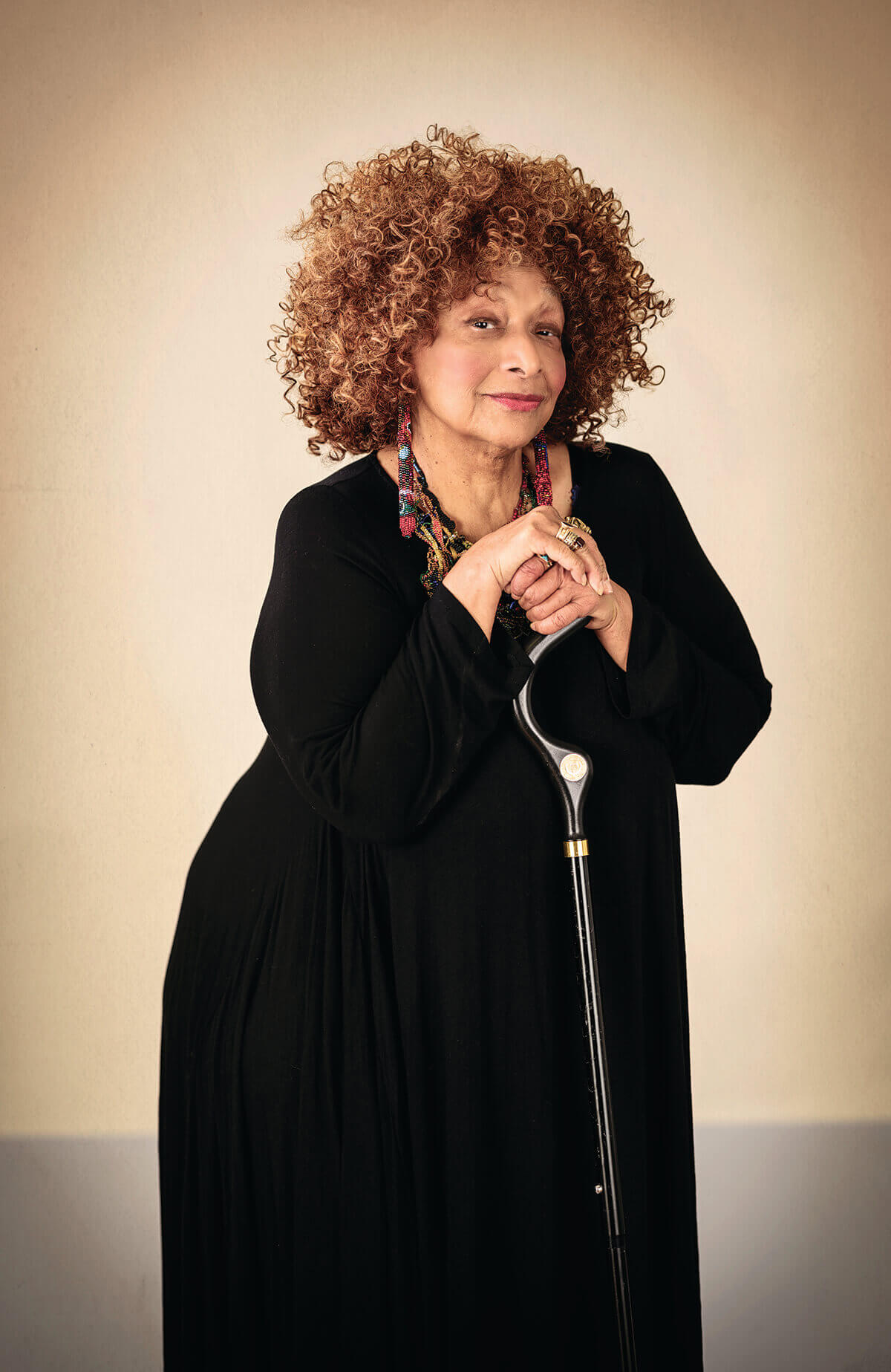
JOYCE J. SCOTT IS A WEST BALTIMORE-BORN and -educated sculptor, jewelry maker, quilter, lecturer, accomplished singer, and performance artist whose creative journey has been nothing short of astounding. As I began my scholarly art history career, Joyce and her mother, Elizabeth Talford Scott, a legendary quilt and fiber artist, provided me with master classes on the transmission of African Diasporic aesthetic traditions and how the retention of those traditions is essential to the expansive legacy of American art and culture. A natural teacher and mentor to younger and emerging artists, Joyce intentionally chose the path of a self-employed artist to safeguard the integrity of her mission and the meaning behind her distinctive aesthetic.
“Joyce functions as a powerful disruptor, a brilliant situation-inverter, hypersensitive to everything in view...”
Her multimedia artistry celebrates iconic s/heroes as it fearlessly confronts injustice, racism, and homophobia, and contests the histories and mis/representations of marginalized people. An empath, Joyce is committed to agitating sensibilities in hopes her communities and audiences will become more consciously “woke” and responsive and responsible to the well-being of all humankind. She began to address the enormity of these issues with the most humble of materials—a bead and button; needle and thread—and evolved into an incredible change agent, as acknowledged by a MacArthur Foundation Genius Grant in 2016 and a Johns Hopkins University honorary doctorate in 2022.
Also gifted with an outrageous, raucous, bewitching, hilarious, and nutty charm, Joyce loves to lasso unsuspecting individuals into spontaneous jokes, songs, and riotous impromptu performances at any time of the day—or wee hours of the morning. Once while presenting a paper at a University of Paris conference, as I described Joyce’s colorful personality, several hands from the audience flagged my attention. Thinking there were questions, I inquired about their concerns. Instead, someone in shouted in agreement, “I have been abused, too!” The French audience howled with laughter. Her persona is akin to the revered, and sometimes feared, trickster deities who play critical roles in global cultures, especially in African-Diasporic and Indigenous-American belief systems. In this way, in her work and her being, Joyce functions as a powerful disruptor, a brilliant situation-inverter, hyper-sensitive to everything in view as she critiques questionable moralities through her artistry.
My first encounter with Joyce occurred in the mid-1970s, when I was completing my art history doctorate at Johns Hopkins University. Walking across campus to a local art fair, I saw a woman who had wedged herself between two “legitimate” vendors with a huge display case on her lap. My curiosity led me to her jewelry of beads and repurposed buttons, beautiful work which immediately fascinated me, and before I knew it, I’d fallen into her witty trap. She waxed on about being a single parent with five children, needing money for support, food, clothing, supplies—everything, in other words. Instantly, I realized I was in the company of an original artist in theatrical presentation. Several weeks later, sitting on our marble steps as my husband, O’Neill Hammond, washed his antique car, she unexpectedly came walking down the street. O’Neill and Joyce, it turned out, were classmates at Maryland Institute College of Art. We quickly became fast friends and, as our relationship grew, Joyce pulled together an entire sisterhood of women in the arts known as The Girls of Baltimore—a posse that includes Linda DePalma, Oletha DeVane, Ellen Burchenal, Patti Tronolone, Linda Day Clark, Amy Raehse, and Lowery Sims—all of whom have continued to work together on significant local and national projects for more than 30 years.
When she received her MacArthur Fellow recognition, Joyce called it “truly a Baltimore award.” “It shows that someone can have a profound voice in the arts and still live in her community,” she said, and that, “great things can happen to you right where you are.”
Yet, be cautioned. Should you ever meet Joyce, be on guard. You, too, might just become the next target of one of her wild performative interventions!
Leslie King Hammond is the founding director of the Center for Race and Culture at the Maryland Institute College of Art, where she is also graduate dean emerita.

By Carla Du Pree
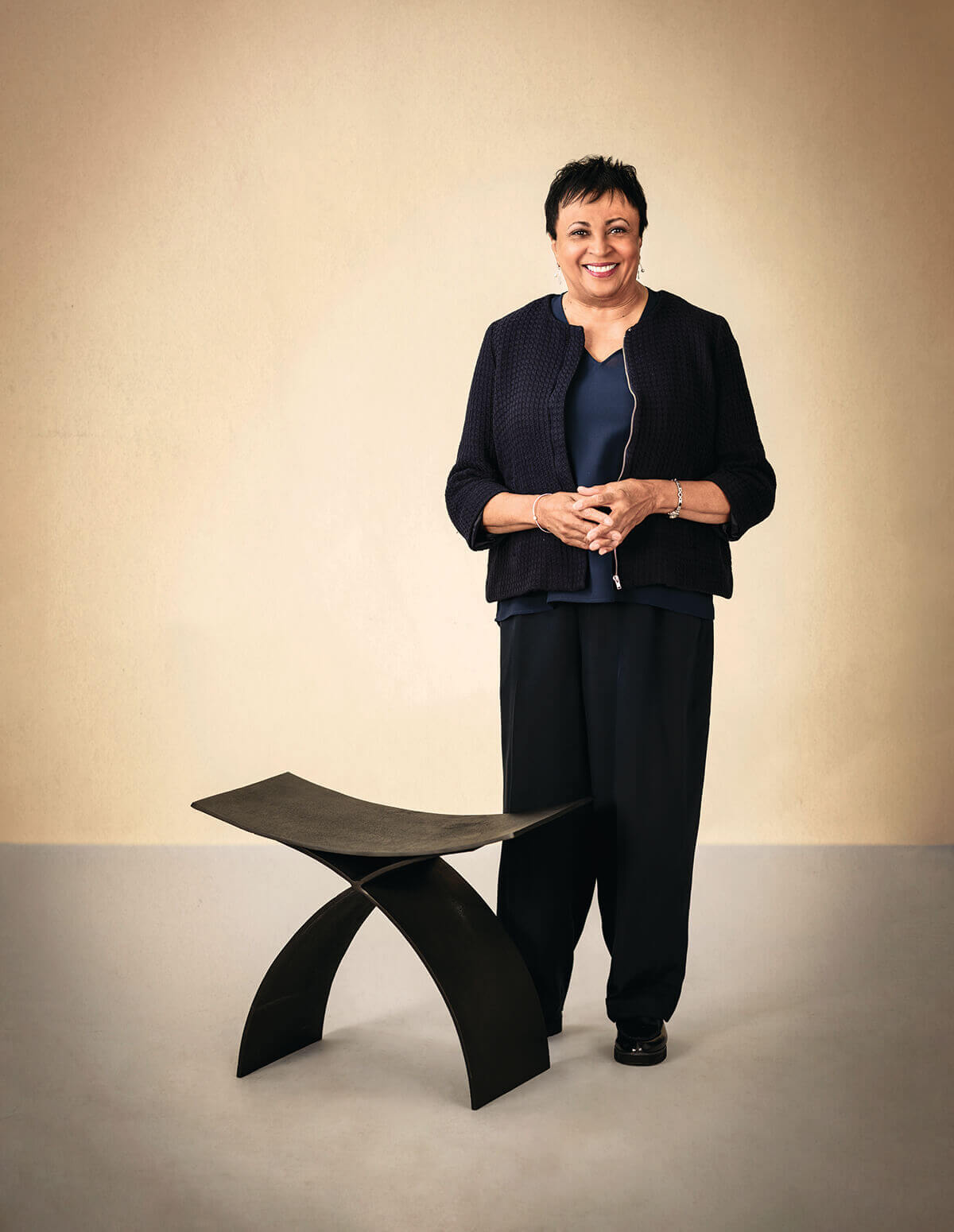
STOOL COURTESY OF ARHAUS
“CURIOSITY IS, in great and generous minds, the first passion and the last,” wrote author Samuel Johnson. When I think about libraries and all of what they mean, the person who comes to mind is Carla Hayden, the long-serving CEO of the Enoch Pratt Free Library, and now, of course, the 14th Librarian of Congress. More than that, what she represents to me, fellow book lover, the other Carla with a “C,” is a pursuer of curious things.
The world of language and books stoked a furtive imagination in me as a child. I grew up an army military brat, traveling across the country, and spending five years in Germany during the height of the Civil Rights Movement. I eventually found my “home” in a New Jersey public library, surrounded by books and the promise they held. It’s a story I’ve told too many times to count, but I didn’t learn about Black poets and writers—Amiri Baraka, Lucille Clifton, Haki R. Madhubuti, Sonia Sanchez, and Nikki Giovanni—until I was in 6th grade. I discovered them on my knees, while scanning a row of books on the bottom shelf in our local library.
Fast forward many years later. When I learned the head of the Enoch Pratt Free Library was a Black woman, it took my love of libraries to another level. It was as if one of those Black women writers on the bottom shelf was now in charge of this massive and historic institution, which was some kind of wild transfiguration. Representation was everything. I joined CityLit in the summer of 2016; just months later Carla would be appointed by President Obama, whose inauguration I attended on that freezing January day. Like many, the surge of hope in that moment was palpable. When she became this country’s first woman and first African-American national librarian, needless to say, I was beside myself with pride and admiration.
Years later, watching Carla raise the volume on the national library’s Poet Laureate program, assist minority communities preserve their histories through digital record-keeping, and showcase Lizzo playing a 200-year-old crystal flute once owned by President Madison (the video went viral!) has been incredible. She is always helping us see libraries in new and fuller forms.
”She is a purveyor of what’s possible when you invite people into a large place with walls of learning.”
I was thankful to have eventually discovered my tribe in a library in a small town in New Jersey and, once again, as the recently hired, passionate executive director of Baltimore’s CityLit Project. Carla didn’t know it, but she was already a literary rock star to me when we first met. I knew the CityLit Festival had a strong affiliation with the Pratt since its origin in 2004. During Carla’s tenure at the Pratt, the CityLit Festival and library hosted renowned authors like George Saunders, Claudia Rankine, Edward P. Jones, and Junot Díaz. But it was during the Baltimore Uprising where the Pratt truly proved to be a haven in the storm, with Carla making the brave decision to keep all the libraries open in the immediate aftermath, including the Pennsylvania Avenue branch, directly across from the CVS Pharmacy that had been set on fire. With tanks outside of the Central Library’s midtown doors, the library remained open for the CityLit Festival shortly after the Uprising. It was a smaller festival than usual, but with an audacious presence given the circumstances and the headliner, National Book Award finalist John Darnielle.
Carla Hayden has meant a lot of things to many people. She is a woman of words. A book lover determined to swing wide those open doors and help us understand our past, present, and maybe even our future. She is a purveyor of what’s possible when you invite people into a large place with walls of learning. She shows up for the people’s culture and represents access to knowledge and learning. Her brown face and striking eyes also embrace you with a warmth that welcomes you “home” whenever you were entering the Pratt, and now the Library of Congress. She makes you feel they’re not just libraries, but your libraries. I’m not ashamed to say I revere her, and she is a symbol of the power of books in living form to me. And yes, I’m fangirlin’, for real.
Carla Du Pree is a fellowship-winning fiction writer and the executive director of Baltimore’s CityLit Project.

By Jed Dietz
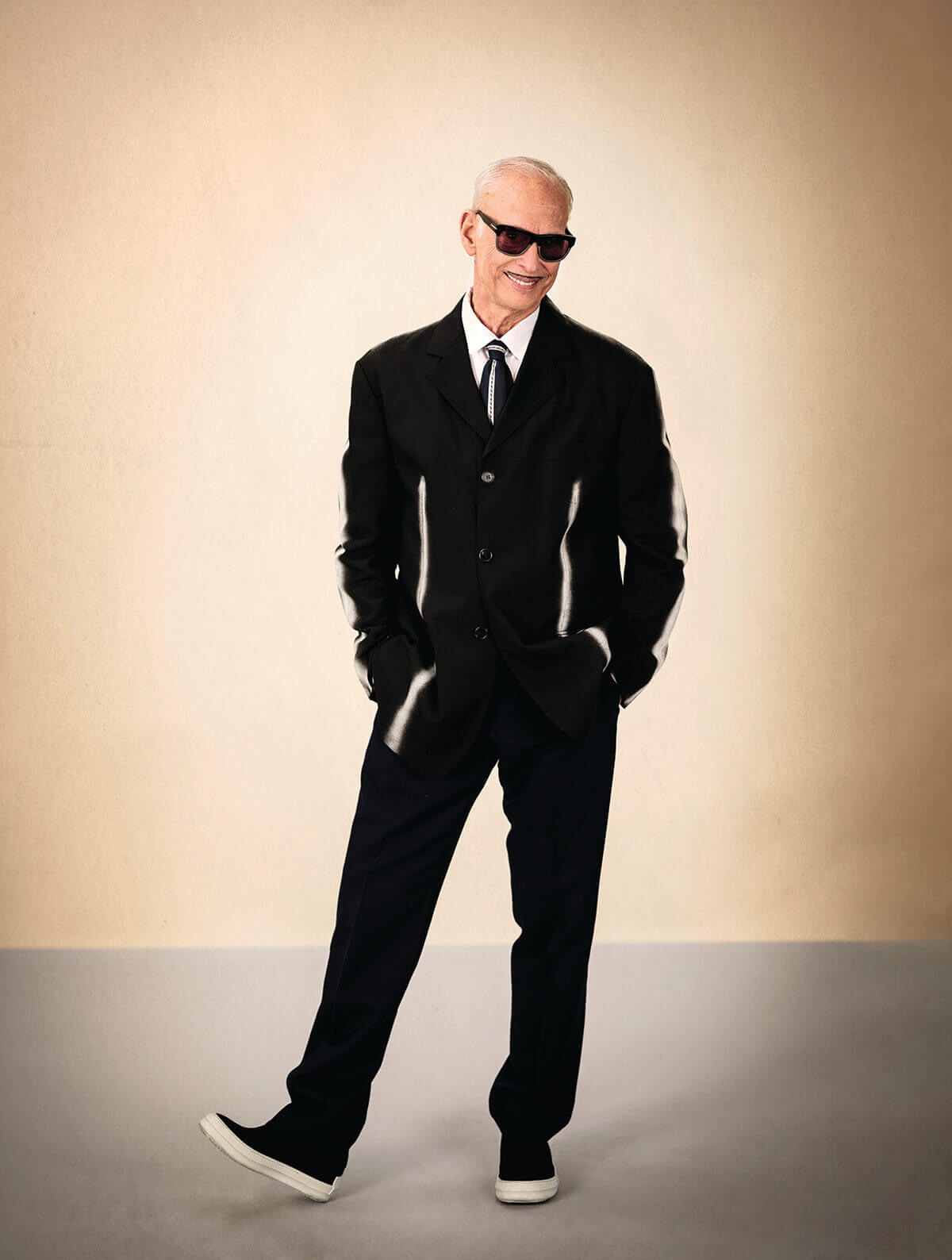
JOHN WATERS IS A SINGULAR CITIZEN of Baltimore. He travels widely for work, filling far-flung venues like the Sydney Opera House, and spends significant time in New York, San Francisco, and Provincetown. He cares about filmmaking, fashion, and the visual arts—none of which are centered in Baltimore. However, the first thing you must know about John is that he is a Baltimore son. And, most importantly, he has taught us to not just accept the things that make us different, but to celebrate those things. Along the way, John has put Baltimore on the culture map over and over during a period when American society has changed dramatically.
“...he has taught us to not just accept the things that make us different, but to celebrate those things.”
John is certainly perceptive and funny. He also works incredibly hard. He gets up early, isolates himself for part of the day to concentrate on things only he can do, and is scheduled with meetings and phone calls deep into the night. Some evenings, he then looks for new music acts around town or watches a movie he has been sent. Preternaturally suspicious of institutions, he has nonetheless given generously to local organizations, including, most recently, his gift of his incredible art collection to the BMA.
Beyond his seminal work in film, he’s contributed to the art world as a collector, critic, and practitioner. I’ve seen him advise contemporary artists who were awed by how much he knew about the inner workings of their field. He’s a talented performer and has been a fashion-world influencer long before social media. He’s written unusual and important books—his essay about Leslie Van Houten in Role Models could’ve been written by a legal scholar, except, of course, it’s more entertaining and personal. He’s fascinated by artists and many visiting filmmakers have had the honor of spending a long night with John, touring “mutant bars” and other special Baltimore spots. His attendance at their screenings makes filmmakers nervous; his approval means everything. He’s no softie—I remember his reply to a filmmaker who complained about all the money-grubbing he had to do to make movies. After a pause, John said, “Then get out.”
When we started the Maryland Film Festival, there were plenty of doubters—Baltimore was in decline as an industrial center and losing population. The city was not a major media market or tourist destination, and a previous film festival in town had died a somewhat painful death. The world already had good non-major-market film festivals with strong identities, and even smaller ones with clear missions focused on nonfiction filmmaking, animation, and experimental film. Creating a new role, for our audience and for filmmakers, was a challenge.
All the skeptics in the film community said John and Barry Levinson had to be involved in our first festival, since they were each so identified with Baltimore (“same city, different neighborhoods”). John was skeptical, always wary of the distortion field his fame created, but said he could host a screening of a film he loved and lead a discussion afterwards. He mentioned Boom!, a studio film I’d never heard of, despite the major talent involved (screenplay by Tennessee Williams, starring Richard Burton and Elizabeth Taylor). We opened the first Maryland Film Festival with a documentary Barry Levinson was developing about the original Diner guys.
Both were hits with our audience, and we learned to trust Baltimore was unique, and that would be our strength. John has hosted a screening of a film he has chosen at every Maryland Film Festival since, including a COVID-defying drive-in double feature at Druid Hill Park. One was a documentary filmed with dashboard cameras of car crashes in Russia, The Road Movie, and the second was a feature from Russian director Kirill Sokolov, Why Don’t You Just Die! (one critic noticed influences of Tarantino, Guy Ritchie, Sergio Leone, and Park Chan-wook). John has helped the Maryland Film Festival grow in numerous ways, including serving on our board. He has been part of successful fundraisers, and even got John Travolta to demonstrate dance steps one year.
Baltimore couldn’t have a better member of its family.
